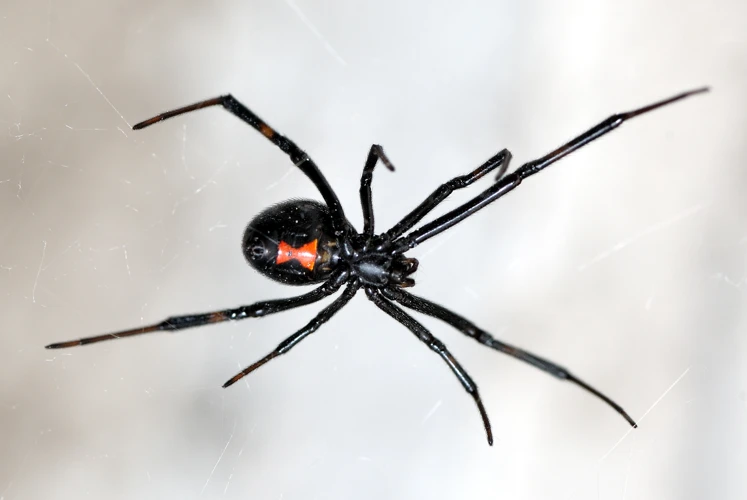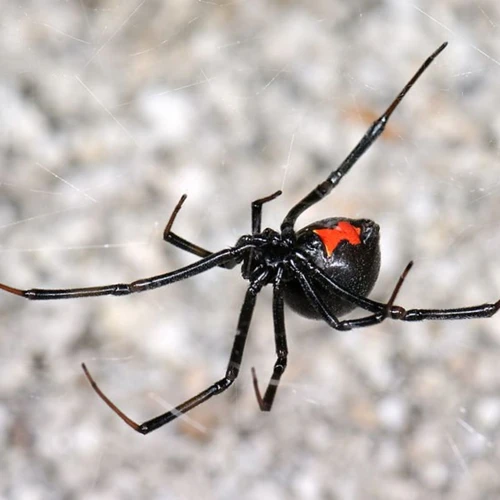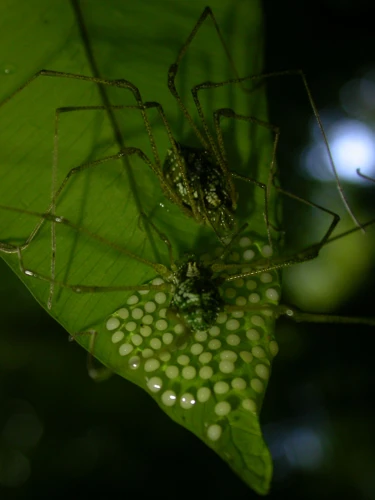As we delve into the world of arachnids, few species are as fascinating as the black widow spider. The black widow is notorious for its venomous bite, but did you know that their reproductive behavior is also of intrigue to scientists and nature enthusiasts? In this article, we will explore all you need to know about parental investment in black widow spider eggs. From mating and fertilization to maternal care and offspring survival, we will dive into the intricate details of this fascinating species. So, grab your magnifying glass and let’s explore the world of black widow spider eggs together!
Reproductive Behavior

The reproductive behavior of black widow spiders is a complex and fascinating topic that has intrigued scientists and arachnologists for many years. From mating and fertilization to egg production and laying, these spiders exhibit unique characteristics that set them apart from other arthropods. Interestingly, the survival of their offspring depends greatly on the investment made by their mothers during the reproductive process. In this section, we will explore the details of the reproductive behavior of black widow spiders, including their mating habits, egg production, and laying patterns. Additionally, we will delve into the maternal care behaviors exhibited by female black widows, which ultimately determine the survival of their young. For more information about other aspects of black widow spider reproduction, check out our related articles: Black Widow Egg Sac Placement and Sperm Storage in Black Widows.
Mating and Fertilization
During mating, the female black widow spider releases pheromones to attract a male. When the male approaches, the female evaluates him to determine if he is a suitable mate. If she approves, the male approaches her and begins to copulate. Mating can last from several minutes to several hours, and during this time, the male transfers his sperm to the female’s genital opening through a specialized structure called the pedipalp.
Once fertilized, the female will begin producing a large number of eggs, which she will store in her abdomen until they are ready to be laid. This process can take several days to several weeks, depending on the size of the female and other factors such as temperature and food availability. When the female is ready to lay her eggs, she will spin a silk cocoon and lay her eggs inside it.
It is interesting to note that sometimes, the female black widow spider may engage in cannibalism when the male attempts to mate with her. This behavior is more common when the female is hungry or stressed. This cannibalism can be beneficial for the female as it provides her with necessary nutrients for egg production and increases the chances of successful offspring.
The reproductive behavior of the black widow spider exhibits fascinating adaptations to ensure the survival of the species. To learn more about the factors affecting egg development, you can read our article on Factors Affecting Egg Development in Black Widow Spiders.
Egg Production and Laying
The process of egg production and laying in Black Widow Spiders is a crucial stage in their reproductive cycle. Female spiders are the ones responsible for producing and laying the eggs, and this process is determined by several factors such as food availability, temperature, and mating success.
According to a study conducted by researchers, the size of the female Black Widow Spiders significantly affected their potential egg production. Females with larger bodies tend to produce more eggs than smaller ones. These eggs are then stored in the female’s abdomen until they are fully matured and ready to be laid. In some cases, female spiders may store sperm from multiple males and produce offspring with mixed paternity.
Once the eggs are matured, the female spider will build an egg sac to protect and nourish the developing embryos. These egg sacs have unique features such as silk coverings, which protect the eggs from predation and weather changes. Additionally, the egg sacs have a robust structure and are made from silk mixed with the female’s digestive fluids, which offer a nutritious environment for the spiderlings.
On average, a female Black Widow Spider can lay around 250 eggs per egg sac, but this number may vary depending on the species and individual. Certain factors such as stress, food availability, and presence of predators or parasites may also reduce the number of eggs produced.
Interestingly, female Black Widow Spiders are known to exhibit egg cannibalism behavior, which may serve as a source of nutrition during the egg-laying period. This behavior involves the consumption of some of the eggs produced, and it is believed to be a survival strategy for the female spiders.
Egg production and laying in Black Widow Spiders is a complex process, influenced by various factors such as size, food availability, and mating success. The quality and quantity of the eggs produced play a crucial role in ensuring the survival of the offspring. If you want to learn more about Black Widow Spider eggs, you can check out our article on Black Widow Egg Sacs.
Maternal Care

Many spider species lay their eggs and abandon them, leaving the offspring to fend for themselves. However, the black widow spider exhibits unique maternal care behaviors that are crucial for the survival of their offspring. These behaviors include building an egg sac, guarding their eggs, and ensuring their offspring’s survival. This section explores the fascinating world of maternal care in black widow spiders, shedding light on their survival strategies and ensuring the growth and development of the spiderlings within the eggs. To learn more about the black widow’s egg production and cannibalism, check out our articles on egg cannibalism and egg production.
Building the Egg Sac
After the eggs are fertilized and deposited by the female black widow spider, the next step is for the mother to build the egg sac. The egg sac serves as a protective enclosure for the developing spiderlings and it is built using silk. This egg sac is a crucial component to ensure the survival of the spiderlings.
Building the egg sac:
- The egg sac is made of several layers of silk, which adds to the durability of the sac.
- Studies have shown that black widow spiders produce an average of 8 egg sacs, each containing around 250 eggs.
- The mother spider carefully constructs the sac around the eggs by using her spinnerets, which are at the rear of her abdomen.
- The silk used to build the sac is made from a protein produced in the spider’s body, which is then released through her spinnerets.
- The silk is strong and stretchy, making it a perfect material to withstand any potential predators.
- It is essential that the egg sac is constructed correctly because it must provide a safe environment for the spiderlings to develop until they are mature enough to survive on their own.
- Interestingly, the shape of the sac may vary depending on the species of spider. For example, some species of black widow spider build egg sacs that are more spherical, while others create egg sacs that are more cylindrical in shape.
It is intriguing to see how the black widow spider’s maternal care develops during the egg production process. With a well-constructed egg sac, the spiderlings are more likely to survive and become mature individuals that continue their species. This is just the first step towards ensuring that the black widow spider successfully reproduces, given the numerous other challenges the spiderlings will face as they grow. To read more about maternal care in black widow spider eggs, visit /maternal-care-black-widow-spider-eggs/.
Guarding the Egg Sac
Once a black widow spider has produced its egg sac, it will fiercely guard it until the spiderlings emerge. During this time, female black widows will exhibit intense maternal care behaviors and will even attack any potential threats to the egg sac. This is because the survival of her offspring is of the utmost importance.
1. Aggressive Behavior: Female black widows are highly aggressive and will attack any potential threats with a venomous bite. They will not hesitate to attack larger predators, and even humans, who can pose a danger to their eggs.
2. Consistent Monitoring: Female black widows will stay close to the egg sac, continuously monitoring and tending to it. They will use their elongated front legs to detect any movements or vibrations that may signal danger.
3. Sacrificing Themselves: In some cases, female black widows will sacrifice themselves to protect their egg sacs. When threatened, they may lure predators away from the egg sac or even allow themselves to be eaten to ensure the survival of their offspring.
Maternal care and guarding of the egg sac are critical to the survival of the black widow spider’s offspring. Studies such as the recent one on black widow eggs have shed light on the importance of egg sac count and egg hatching synchrony in the success of black widow spiders in the wild.
Offspring Survival
As black widow spider mothers invest a lot of time and energy in producing and guarding their precious eggs, it’s no wonder that offspring survival is of utmost importance. While they may face challenges such as egg sac parasitism and a harsh environment, these spiderlings have evolved various adaptations to increase their chances of survival. Let’s explore some of the strategies they use to make it to adulthood.
Egg Sac Parasitism
Black widow spiders face a common challenge when it comes to egg sacs: parasitism.
Parasitism occurs when other species lay their eggs inside or on the black widow’s egg sacs. These eggs then hatch and consume the spider eggs inside. This can be a significant threat to the survival of the black widow’s offspring, but the spider has a fascinating evolutionary adaptation in response to it.
Table: Parasitism in Black Widow Spider Egg Sacs
| Species | Behavior | Impact on Black Widow Spider Offspring |
|---|---|---|
| Parasitoid Wasps | Lay their eggs inside the egg sac | Can consume all spider eggs inside the sac |
| Flies | Lay their eggs on the surface of the egg sac | Spiderlings can still hatch and survive |
Black widow spider females have been found to counteract parasitism by building multiple egg sacs in different locations. This strategy ensures at least some offspring will survive even if one or more egg sacs fall victim to parasitism.
Additionally, recent research has found that a certain scent produced by the black widow spider may act as a deterrent to parasitoid wasps. The scent, a chemical compound called naphthalene, is found in higher concentrations in the silk of the egg sac than in the female spider’s body. While more research is needed to fully understand the mechanism behind this defense, it is an exciting discovery in the ongoing study of parental investment in black widow spider offspring.
Egg sac parasitism is a significant threat to the survival of black widow spider offspring. However, the spider has evolved various strategies to counteract this threat, including building multiple egg sacs and producing a scent that may act as a deterrent. The study of these strategies not only sheds light on the fascinating behavior of black widow spiders but also has implications for understanding the evolution of parental investment in other species.
Spiderling Development
Once the spiderlings hatch from the eggs, they go through a process of development that is crucial for their survival. The female Black Widow Spider invests a significant amount of energy into ensuring the success of their offspring.
During the early stages of their development, the spiderlings feed on the yolk reserves within their egg sac. As they grow larger, they start to feed on other insects, such as fruit flies. It’s essential to provide a suitable habitat for the spiderlings to ensure their survival.
Here’s a table below summarizing the developmental stages of Black Widow Spider’s offspring:
| Developmental Stage | Description |
|---|---|
| First Instar | The spiderlings are about 2mm in size and white in color. They start to consume the remaining yolk in their egg sac. |
| Second Instar | The spiderlings have molted and are about 3mm in size. They begin to hunt for small insects. |
| Third Instar | The spiderlings are about 5mm in size and are sporting the characteristic red hourglass on their abdomen. |
| Fourth Instar | The spiderlings are about 7mm in size and start to exhibit sexual dimorphism. Males are lighter in color and have longer legs than females. |
| Fifth Instar | The spiderlings are about 10mm in size and are almost fully grown. They will molt for the final time, shedding their skin and growing into adults. |
After the fifth instar, the spiders will reach maturity and start the process all over again, starting with mating and laying eggs. It’s essential to note that, without proper maternal care, the spiderlings’ chances of survival decrease drastically. The mother’s investment in building and guarding the egg sac can be the difference between life and death for her offspring.
Conclusion
After diving into the world of black widow spider parental investment, we can conclude that these spiders have a unique reproductive behavior and maternal care system. Female black widow spiders are known for their impressive egg production and the construction of carefully designed egg sacs. Once constructed, the female black widow exerts extraordinary maternal care over her eggs by guarding them and ensuring their survival.
Despite the impressive maternal care of the female black widow spider, offspring survival is still not guaranteed. Eggnapping, a parasitic behavior by other insects, can lead to the demise of the eggs. Additionally, spiderling development can be chaotic and may result in cannibalism and a smaller number of mature offspring.
It is clear that despite the risks, black widow spiders invest a significant amount of energy and resources in their offspring. While this may seem puzzling, it is important to note that this reproductive behavior ensures the continuation of the species.
In conclusion, the black widow spider’s reproductive behavior, maternal care, and offspring survival have provided us with valuable insights into the complex world of animal behavior. The study of these spiders highlights the importance of recognizing the unique parental investment strategies employed by different species and the importance of understanding the impact of varying ecological pressures.
Frequently Asked Questions
What is the reproductive behavior of black widow spiders?
Black widow spiders mate and fertilize internally. The male spider deposits sperm into the female’s genital opening during mating.
How many eggs can a female black widow spider lay?
A female black widow spider can lay anywhere from 200 to 900 eggs, depending on the species.
What is the purpose of the egg sac?
The egg sac serves as protection for the eggs and eventually the spiderlings. It also provides a suitable environment for the spiderlings to develop.
How long does it take for black widow spider eggs to hatch?
Black widow spider eggs take about 20-30 days to hatch.
Why do female black widow spiders guard their egg sacs?
Female black widow spiders guard their egg sacs to protect their offspring from predators and environmental factors that could harm them.
What is egg sac parasitism?
Egg sac parasitism is when other insects or spiders lay their eggs in the black widow spider’s egg sac, leading to the death of the spiderlings.
How long does it take for black widow spiderlings to reach adulthood?
It takes about 3-4 months for black widow spiderlings to reach adulthood.
Do black widow spiderlings stay with their mother after hatching?
No, black widow spiderlings disperse soon after hatching and must fend for themselves.
Can black widow spiders be kept as pets?
While some people do keep black widow spiders as pets, it is not recommended due to their potentially dangerous venom.
Are black widow spiders found all over the world?
No, black widow spiders are mainly found in warm, dry regions of the world, including North and South America, Africa, and southern Europe.






